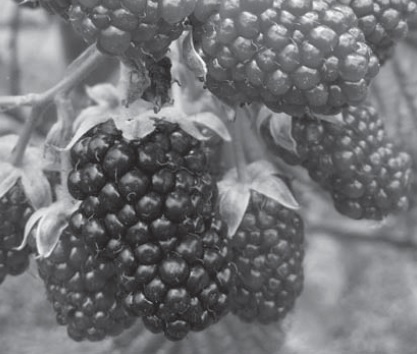Growth rates in blackberry (Rubus alpinus Macfad) plants under different pruning systems

Abstract
In Colombia, the blackberry is an important perennial crop for the economic sustainable development of medium and smallholder farmers. Pruning is essential for this crop and aims to renew the productive, fruit bearing branches and normalize the sink-source relationships of photoassimilates. The establishment of physiological indices and growth curves for blackberry crops with different pruning practices will develop proposals for the agricultural handling of this species. In this study, two-year-old blackberry crops were used with a T-trellis; 48 canes were grouped into three pruning treatments; a) control: without pruning; b) short pruning: canes with a 1.6 m length; and c) long pruning; canes with a 2.6 m length. The length of the canes, and the number of leaves and panicles were registered over time, in terms of days after sprouting. The curves and rates of growth were established with a functional analysis. The logistic model was ideal for expressing the growth of the plants. The maximum length of the canes was seen at 231 days after sprouting: 535 cm. The relative growth rate of the canes decreased gradually over time. The values of the absolute growth rate of the canes as well as the number of leaves and panicles decreased over time too. The maximum number of leaves was seen from 55 to 231 days after sprouting; the flowering in the plants in the pruned treatments started at 126 days after sprouting. The average number of inflorescences was 18 in the shrubs without pruning, 10 with the short pruning and 21 with the long pruning. The results showed that pruning is a determinant factor in the physiological and productive development of blackberry shrubs and that the long pruning, with a 2.6 m length, was the best pruning alternative.
Keywords
Growth curve, Growth rate, Panicles, Logistic model, Sprouting
Supplementary File(s)
Sin título (Español)References
- Aliquó, G., A. Catana, G. Aguado. 2010. La poda de la vid. Secretaría de Agricultura, Ganadería, Pesca y Alimentación – Instituto Nacional de Tecnología Agropecuaria (INTA).
- Barceló, C.J., G. Nicolás, B. Sabater y R. Sánchez. 1987. Fisiología vegetal. Ediciones Pirámide, Madrid. pp. 429-441.
- Barraza, F., G. Fischer, C. Cardona. 2004. Estudio del proceso de crecimiento del cultivo del tomate (Lycopersicon esculentum Mill.) en el Valle del Sinú medio, Colombia Agronomía Colombiana. 22 (1), 81-90.
- Cancino, O., L. Sanchez, E. Quevedo y C. Díaz. 2011. Caracterización fenotípica de accesiones de especies de Rubus L. de los municipios de Pamplona y Chitagá, región Nororiental de Colombia. Universitas Scientiarum. 16 (3), 219-233.
- Casierra-Posada. F., D. Hernández, P. Lüdders y G. Ebert. 2003. Crecimiento de frutos y ramas de manzano ‘Anna’ (Malus domestica Borkh) cultivado en los altiplanos colombianos. Agronomía Colombiana 21(1-2): 69-74.
- Casierra-Posada. F., F. Barreto y O. Fonseca. 2004. Crecimiento de frutos y ramas de duraznero (Prunus pérsica L. Batsch, cv. ‘Conservero’) en los altiplanos colombianos. Agronomía Colombiana 22(1): 40-45.
- Casierra-Posada. F., G. Peña, J. Peña. 2007. Estimación indirecta del área foliar en Fragaria vesca L., Physalis peruviana L., Acca sellowiana (Berg.) Burret, Rubus glaucus L., Passiflora mollissima (Kunth) L. H. Bailey y Ficus carica L. Revista U.D.C.A Actualidad & Divulgación Científica 11 (1): 95-102
- Casierra-Posada. F., J. Rodríguez, J. Cárdenas-Hernández. 2007b. La relación hoja:fruto afecta la producción, el crecimiento y la calidad del fruto en duraznero (Prunus persica L. Batsch, cv. ‘Rubidoux’) Rev. Fac. Nal. Agr. Medellín 60 (1), 3657-3669.
- Farinango, M. 2010. Estudio de la fisiología postcosecha de la mora de castilla (Rubus glaucus Bent) y mora variedad brazos (Rubus sp). Tesis de pregrado. Escuela politécnica nacional, Facultad de ingeniería química y agroindustria, Quito Ecuador.
- Franco, G. y M. Giraldo. 2000, El cultivo de la mora. 3ed. Manizales: ICA, 75p.
- García, M y H. García. 2001. Manejo cosecha y poscosecha de mora, lulo y tomate de árbol, Corpoica, Primera edición, Bogotá, Colombia 99p.
- Giraldo, M y G. Franco. 2002. El cultivo de la mora. Manizales (Colombia): CORPOICA-PRONATTA. 130p.
- Gómez, R y H. Pinilla. 2010. Desarrollo en armonía ambiental: El caso de la Vereda Peñas Blancas del municipio de Arcabuco, Boyacá. Cultura científica. 8, 65-74.
- Graber, U. 1997. Fenología de los cultivos: mora de Castilla (Rubus glaucus B.) Granja Experimental. Píllaro. Ecuador. 22.
- Hunt, R. 1982. Plant Growth Curves. The Functional Approach to Plant Growth Analysis. Edward Arnold, Londres, Reino Unido.
- Mejía, B. 2011. Caracterización morfoagronómica de genotipos de mora (Rubus glaucus Benth) en la granja experimental. Informe técnico del proyecto de investigación. Tumbaco, Quito. INIAP.
- Ministerio de Agricultura y Desarrollo Rural. 2014. Base de datos de la Producción de Frutas y Hortalizas 2007-2014. Disponible en: http://www.agronet.gov.co/Paginas/estadisticas.aspx
- Monasterio- Huelin, E. 1995. Biología de reproducción en Rubus L (Rosaceae) Propagación vegetativa. Anales Jard. Bot Madrd. 52 (2), 145-149.
- Parra-Quezada, R. Á., V. Guerrero-Prieto, J. Arreola-Avila. 2007. Efecto de fecha y tipo de poda en frambuesa roja 'Malling autumn Bliss' revista chapingo serie horticultura, 13 (2), 201-206.
- Potter D., T. Eriksson, R. C. Evans, S. Oh J.E.E. Smedmark, D. R. Morgan, M. Kerr, K. R. Robertson, M. Arsenault, C. Campbell. 2007. Rosaceae phylogeny and classification. Plant Systematics and Evolution.5-43.
- Reynier, A. 1989.Manual de viticultura. Cuarta edición. Ediciones Mundi-Prensa, Madrid, España.382 p.
- Salter, T.B. 1845, Observations on the genus Rubus. Phytologist .139 p.
- Taiz, L. y E. Zeiger. 2006. Plant physiology, 4a ed. Sinauer Associates, Sunderland, MA.
- Tourn, M., D. Barthélémy, J. Grosfeld.1999. Una aproximación a la arquitectura vegetal: conceptos, objetivos y metodología. Boletín de la Sociedad Argentina de Botánica 34: 85-99.
- Villar, R., J. Ruiz. J. Robleto, L. Quero, P. Hendrik, F. Valladares, T. Marañón. 2004 Tasas de crecimiento en especies leñosas: aspectos funcionales e implicaciones ecológicas. Ecología del bosque mediterráneo en un mundo cambiante. Ministerio de Medio Ambiente, EGRAF, S. A., Madrid. ISBN: 84-8014-552-8
